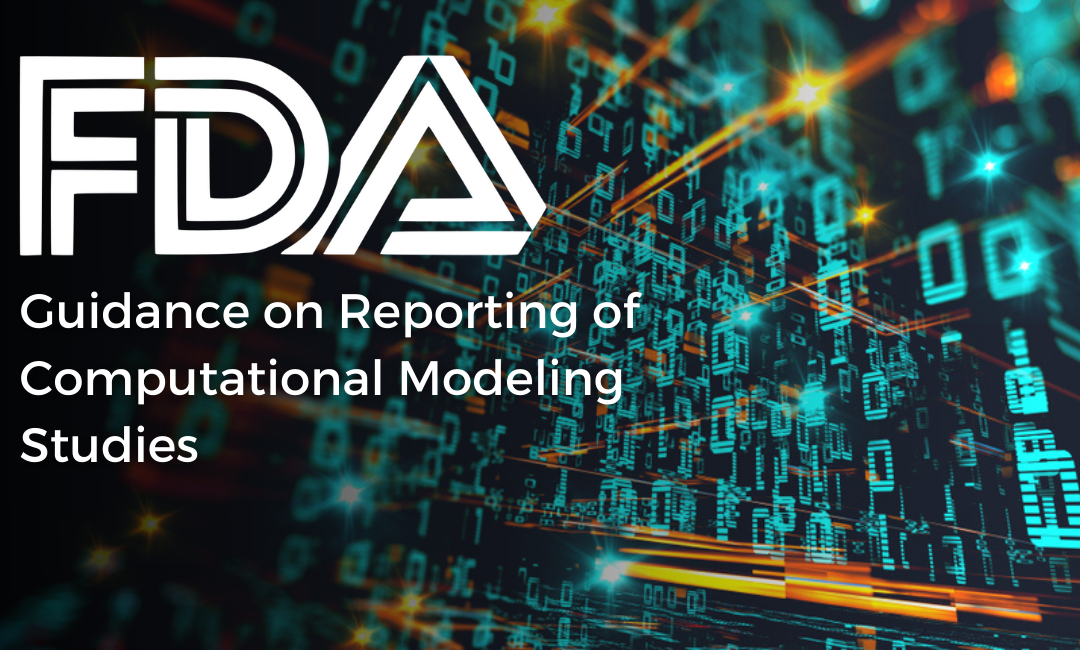The Food and Drug Administration (FDA or the Agency), the US regulating authority in the sphere of healthcare products, has published a guidance document dedicated to the reporting of computational modeling studies in medical device submissions. The latest version of the document was issued by the FDA in September 2016.

Due to its legal nature, the present document does not introduce new rules and requirements the parties involved shall follow but provides additional recommendations and clarifications to be considered. Moreover, the Agency also states that an alternative approach could be applied, provided such an approach complies with the applicable regulatory requirements and has been approved by the authority in advance. Thus, the provisions of the document are not binding and could be subject to changes reasonably necessary to reflect changes in respective legislation.
Table of Contents
Regulatory Background
The computational modeling and simulation (CM&S) studies addressed in the present FDA guidance are widely used by medical device manufacturers in the context of fluid dynamics, solid mechanics, electromagnetics and optics, as well as ultrasound propagation. The document describes the way CM&S studies should be reported in the course of medical device submissions.
The studies to which the present guidance is dedicated could be carried out in order to evaluate the safety and effectiveness of medical devices. In order for the study results to be admissible, the appropriate reports should contain all necessary information. The Agency emphasizes that for the purpose of the guidance, the term “CM&S report” refers to the part of a regulatory submission that provides information about a CM&S study; the term does not describe a new submission requirement.
The authority encourages the use of a unified format of reporting in order to streamline the regulatory procedures and improve their predictability. However, the Agency acknowledges that the level of details included in a report could vary depending on the context of use. Thus, the present guidance provides only the main high-level recommendations to be considered irrespective of the specific aspects that could take place. In particular, the FDA states that the five most important aspects to be addressed in a CM&S report are:
- Fluid Dynamics and Mass Transport,
- Solid Mechanics,
- Electromagnetics and Optics,
- Ultrasound,
- Heat Transfer.
The FDA guidance describes the way CM&S study reports could be used to supplement medical device applications. At the same time, verification and validation of such studies fall outside the scope of the present guidance. The scope of the document also does not cover the regulatory requirements for conducting CM&S studies in order to ensure the accuracy and reliability of results. Hence, the scope of the present guidance is limited exclusively to reporting computational modeling and simulation studies.

CM&S Report
The guidance further provides recommendations regarding the structure and content of a CM&S study report the interested party may submit as part of a medical device application. According to the guidance, such a report shall consist of the following sections and elements:
1. Executive Report Summary – a section providing a general overview of the report, including the context of the use of the study, the scope of analysis, its type, and conclusions. It is also recommended to provide the main keywords used in the report to simplify its processing by the FDA.
2. Background/Introduction – general description of the medical device in question and its intended use.
3. Code Verification – a section containing information about the software quality assurance and numerical code verification carried out by the manufacturer. The Agency states that code verification should be performed irrespectively of the software type. According to the document, software quality assurance (SQA) ensures that the code is functioning correctly and produces repeatable results on specified computer hardware and in a specified software environment, while numerical code verification (NCV) ensures correct implementation and functioning of the numerical code, which is typically accomplished by, for example, comparison to bench-mark solutions, method of manufactured solutions. This section should also contain assumptions, simplifications, and rationale.
4. System Configuration – the manufacturer shall also describe the system configuration and components of the device, as well as the methods and software used to generate the system configuration.
5. Governing Equations/Constitutive Laws.
6. System Properties – a section containing the details about the biological, chemical, physical, and physiological properties of the system.
7. System Conditions – e.g., boundary and loading conditions, initial conditions, etc. This information could also be expressed through a graphical representation.
8. System Discretization – a section describing the discretization and refinement techniques used.
9. Numerical Implementation – the details regarding the numerical implementation methodology and/or numerical method used to solve the governing equations.
10. Validation – the general description of the methods used to validate the model.
11. Results – the quantitative results of the study.
12. Discussion of the CM&S study results achieved in the context of their clinical and regulatory relevance.
13. Limitations – some points regarding the way the assumptions and simplifications described in the report could potentially impact the model, the accuracy of the results achieved, and their interpretation.
14. Conclusions indicating whether the study objectives have been achieved.
15. References.

Terminology
In order to assist medical device manufacturers and other parties involved in applying the recommendations provided in the present guidance, the FDA also provides definitions of the most important terms and concepts used therein, including the following:
- Code Verification – the process of determining that the numerical algorithms are correctly implemented in the computer code and identifying errors in the software.
- Computational model – the numerical implementation of the mathematical model performed by means of a computer.
- Constitutive law – an expression which describes the relationship between biological, chemical or physical quantities for a specific material or substance and an external stimuli.
- Governing equation – the mathematical relationship that describes the phenomena of interest.
- Mathematical model – the mathematical equations, boundary values, initial conditions, and modeling data needed to describe the conceptual model.
Apart from the ones listed hereabove, the FDA guidance on CM&S reporting provides the definitions of such terms as “comparator”, “computational domain”, “convergence analysis”, “quantity of interest”, “simulation”, “system discretization”, and others.
Additional Aspects
The present guidance also contains appendixes describing additional aspects to be considered depending on the sphere of a study. These appendixes provide additional details regarding the recommended content of CM&S reports in terms of the scope of the information to be included and its detailing level.
In summary, the FDA guidance on reporting computational modeling studies provides additional clarifications regarding how the appropriate reports could be used in the context of medical device submissions. In particular, the document describes the recommended structure and content of CM&S reports, including the information to be provided and the format to be used.
Sources:
How Can RegDesk Help?
RegDesk is a next-generation web-based software for medical device and IVD companies. Our cutting-edge platform uses machine learning to provide regulatory intelligence, application preparation, submission, and approvals management globally. Our clients also have access to our network of over 4000 compliance experts worldwide to obtain verification on critical questions. Applications that normally take 6 months to prepare can now be prepared within 6 days using RegDesk Dash(TM). Global expansion has never been this simple.

